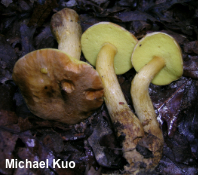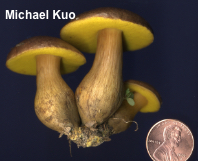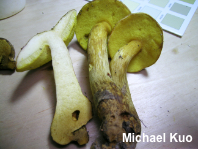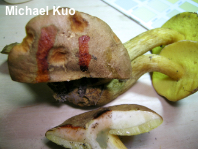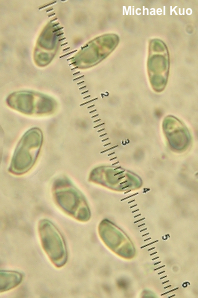| Major Groups > Boletes > Boletus innixus |

|
Boletus innixus [ Basidiomycota > Boletales > Boletaceae > Boletus . . . ] by Michael Kuo Boring from above but gorgeous when flipped upside down, Boletus innixus features an eye-catching bright yellow, nonbruising pore surface. It has a tendency to grow in small clusters, and its stem is often swollen near the bottom, just above a small, tapering "root." Additional features important for identification include the fact that the cap is dry, the yellow basal mycelium, and fairly small spores (9–12 µm long). Aureoboletus auriporus is similar but features white basal mycelium and longer spores; additionally its cap is sticky when fresh, and its stem does not get swollen near the base. Aureoboletus viridiflavus features an olive cap, white basal mycelium, and longer spores. "Aureoboletus innixus" is a name published in an online venue without peer review and without citing any support; as I argue elsewhere such names should not be used until they are supported by science. In this case several studies (Binder & Hibbett 2007, Nuhn and collaborators 2013, Zhang and collaborators 2019) have ostensibly provided support for placement of Boletus innixus in Aureoboletus, but the support is based on DNA sequences of specimens that were not reliably vouchered and saved in public herbaria, and are thus not available to researchers—making the experiment (the extraction of DNA) unrepeatable and, consequently, unscientific. Description: Ecology: Mycorrhizal with oaks and possibly with other hardwoods; growing gregariously, often in small clusters with fused bases; summer and fall; widely distributed in eastern North America from the northeast to the lower Midwest and the southeastern United States, through Texas into Mexico. The illustrated and described collections are from Illinois and Pennsylvania. Cap: 3.5–9 cm; convex, becoming broadly convex; dry; bald; surface often becoming finely cracked and mosaic-like with age; brown to reddish brown; the margin with or without a tiny overhanging sterile portion. Pore Surface: Bright yellow; not bruising; 1–2 angular pores per mm at maturity; tubes to 10 mm deep. Stem: 5–7.5 cm long; 1–1.5 cm thick; usually swollen near the base, just above a small tapered "root"; bald; smooth, or sometimes shallowly longitudinally ridged; not reticulate; dry, or slightly sticky when fresh; yellowish near the apex; dull brown to brown below; basal mycelium yellow. Flesh: Pale yellow; not changing on exposure. Odor and Taste: Not distinctive. Chemical Reactions: Ammonia pink to red on cap (occasionally green); negative on flesh. KOH red to dull orange on cap; dull orange on flesh. Iron salts negative to greenish gray on cap; negative to gray on flesh; dark olive on pore surface. Spore Print: Olive. Microscopic Features: Spores 9–12 x 4–5 µm; ellipsoid to subfusiform; smooth; hyaline to yellowish in KOH. Hymenial cystidia 30–50 x 7.5–12.5 µm; fusiform to lageniform; smooth; thin-walled; hyaline in KOH. Pileipellis a cutis or collapsing trichoderm; elements 5–10 µm wide, smooth, hyaline to yellow or golden in KOH; exserted terminal cells cylindric with rounded apices. REFERENCES: Frost, 1874. (Snell & Dick, 1970; Smith & Thiers, 1971; Grund & Harrison, 1976; Both, 1993; Both, 1998; Bessette, Roody & Bessette, 2000; Roody, 2003; Binder & Hibbett, 2007; Binion et al., 2008; Klofac, 2010; Nuhn et al., 2013; Kuo & Methven, 2014; Baroni, 2017; Sturgeon, 2018; García-Jiménez et al., 2019; Zhang et al., 2019.) Herb. Kuo 08050308, 08280902, 07131403, 07201403, 08281903. This site contains no information about the edibility or toxicity of mushrooms. |
© MushroomExpert.Com |
|
Cite this page as: Kuo, M. (2020, January). Boletus innixus. Retrieved from the MushroomExpert.Com Web site: http://www.mushroomexpert.com/boletus_innixus.html |
